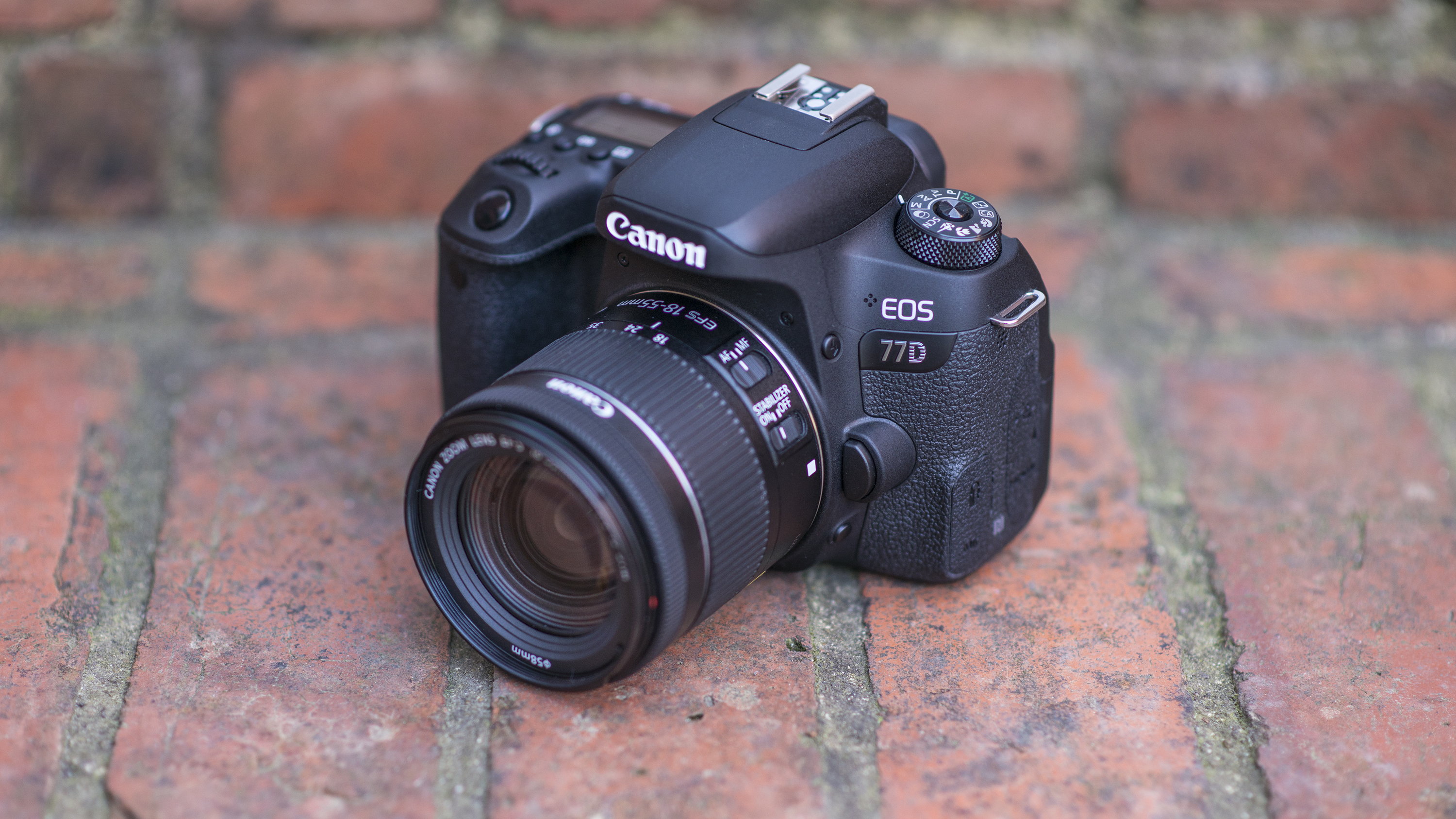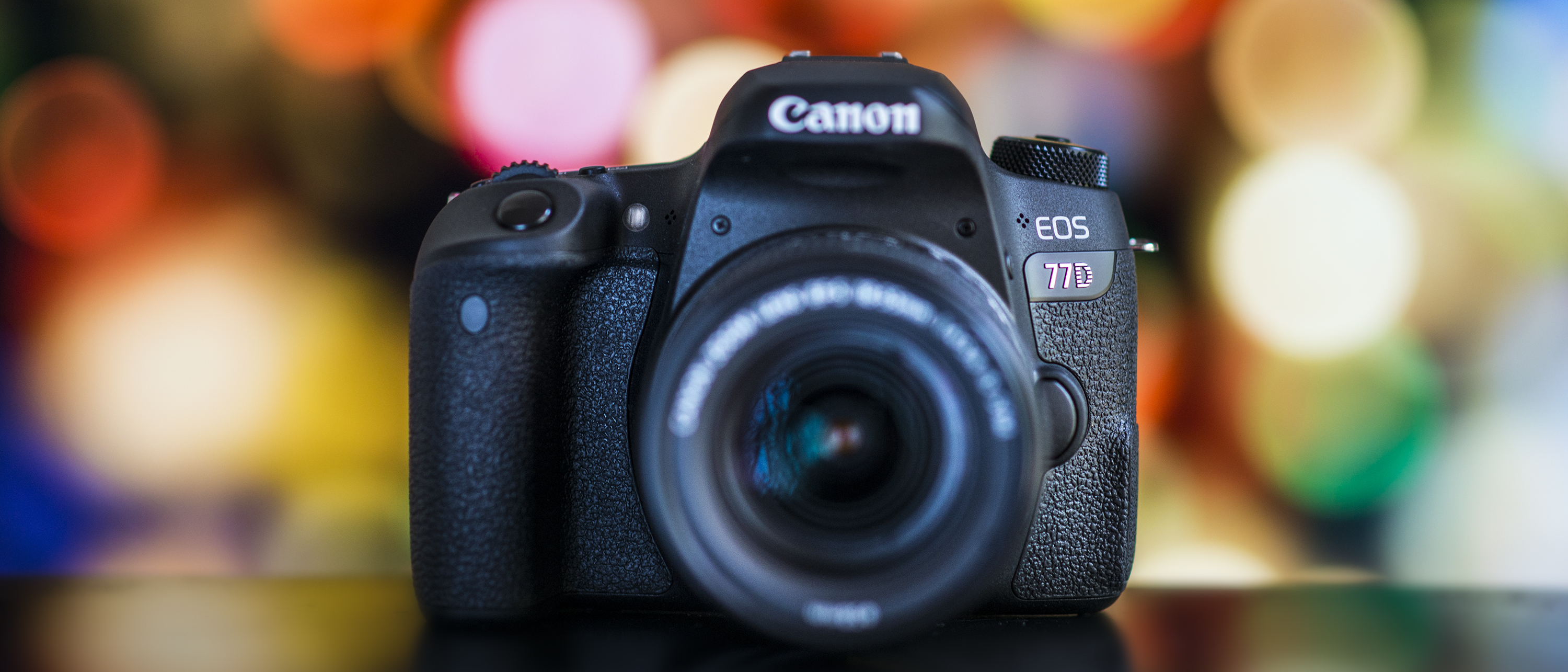Why you can trust TechRadar
Build and handling
- Aluminum alloy and polycarbonate construction
- Design features a top-plate LCD
- Weighs 540g
If the EOS Rebel T7i / 800D and more enthusiast-orientated EOS 80D had a baby, the EOS 77D would be it.
It's proportionally larger than the T7i / 800D, but not quite as large as the EOS 80D, sitting neatly in between the two in the range.
The build and finish of the EOS 77D is most closely related to that of the T7i, though, with a similar combination of aluminum alloy and polycarbonate resin employed – in fact, it only weighs 8g more than its more compact sibling.
As with the EOS Rebel T7i / 800D though, we have an issue with the ultra-smooth finish on the majority of the exterior, which feels quite plasticky to the touch and at odds with the camera's price. That said, the grip is comfortable and the textured finish has a nice tactile feel.
The number of body mounted controls is where the real differences between the EOS 77D and T7i / 800D become noticeable, starting with the top-plate LCD display, which the latter camera lacks.



It's smaller than the top plate LCD on the EOS 80D, but still provides a quick reference point for a host of key shooting info – ISO setting, aperture and shutter speed, exposure compensation, battery level, Wi-Fi activation and shots remaining.
In front of this display are dedicated controls for ISO and AF, as well as a button to illuminate the LCD in poor light. The positioning of the LCD display means the mode dial moves to the left of the viewfinder, and unlike on the T7i / 800D, it features a locking mechanism; you’ll need to press and hold the central button to spin the mode dial round to the desired setting.
Moving round the back, there's a dedicated AF-On button for back-button focusing, which can be really handy if you regularly shoot using continuous focusing
Moving round the back, there's a dedicated AF-On button for back-button focusing, which can be really handy if you regularly shoot using continuous focusing. Rather than the T7i / 800D's four-way control pad the EOS 77D features a multi-directional control pad encircled by a scroll wheel; this mirrors some higher-end EOS DSLRs, enabling you to quickly toggle key settings, and it's handy when the camera is raised to your eye.
Then there's the EOS 77D's touchscreen interface. We may have liked to have seen something a bit larger, and/or with more resolution, but there’s no quibbling about its functionality. It's nicely integrated into the camera’s interface, works really well and is one of the most polished examples we've seen.
There’s also an optical viewfinder with 95% coverage; this is typical for an entry-level DSLR, but with the EOS 77D having loftier aspirations it’s a little disappointing, especially with similarly priced rivals offering 100% coverage. While it might not seem that much of a difference, you’ll be surprised at how unwanted elements can encroach on the edges of the frame when you review your images.
Autofocus
- 45-point AF, all cross-type
- Sensitive down to -3EV
- Dual Pixel AF for Live View
Like the Rebel T7i / 800D, the EOS 77D takes advantage of a 45-point AF system with all cross-type sensors, which are sensitive in both the horizontal and vertical planes to deliver more accurate focusing. The setup here is a welcome boost over the EOS Rebel T6s / 760D’s modest 19 AF points.
It compares favorably to the Nikon D5600’s 39-point AF system (with 15 cross-type) and while it just loses out to the D7200’s 51-point system for total AF points, that camera, like the D5600, only has 15 cross-type points.
The EOS 77D’s autofocus system is also sensitive down to -3EV, so when light levels drop you should still be able to lock focus on poorly lit subjects, while 27 focus points are sensitive down to f/8 – while it might not be a key selling point for a lot of users, this can handy if you're shooting with a lens that has a maximum aperture of f/4 and you've paired it with a 2x teleconverter, as you'll still be able to take advantage of those 27 points.
Focusing speed was very prompt, with the 77D locking on briskly to our desired target in One Shot AF mode
As we’ve found with the T7i / 800D, which uses the same phase-detect AF system, this array does a very good job. Focusing speed was very prompt, with the 77D locking on briskly to our desired target in One Shot AF mode, even in poor light with the new 18-55mm lens fitted.
When it comes to shooting in continuous (AI Servo) AF mode and tracking a moving subject, there’s a noticeable boost in performance over the T6s / 760D’s 19-point arrangement. It's much more reliable than the older 19-point system, and the EOS 77D also uses its 7560-pixel RGB+IR metering sensor to help track subjects across the frame.
It will still mis-focus the odd shot in a sequence though, while there’s no real customization on offer – for instance, it’s not possible to tell the EOS 77D’s AF system that you want the bias to be towards the front or rear of the frame, while there are none of the advanced presets that more advanced EOS DSLRs, or rivals like the X-T20, offer.
While models higher up the EOS food chain feature a dedicated joystick for AF point selection, the EOS 77D relies on the multi-directional control pad and scroll wheel to do this.
For Live View and video recording the EOS 77D uses Canon's proven Dual Pixel AF technology, which offers 80% coverage of the frame.
We've seen this system in a host of recent Canon cameras, such as the EOS 5D Mark IV and EOS M5, and we've never failed to be impressed by how well it works. It's easily the best system in a DSLR, delivering snappy focusing, even if you want to track a (moderately fast) moving subject.
Current page: Build, handling and AF
Prev Page Introduction and key features Next Page Performance and image qualityPhil Hall is an experienced writer and editor having worked on some of the largest photography magazines in the UK, and now edit the photography channel of TechRadar, the UK's biggest tech website and one of the largest in the world. He has also worked on numerous commercial projects, including working with manufacturers like Nikon and Fujifilm on bespoke printed and online camera guides, as well as writing technique blogs and copy for the John Lewis Technology guide.

